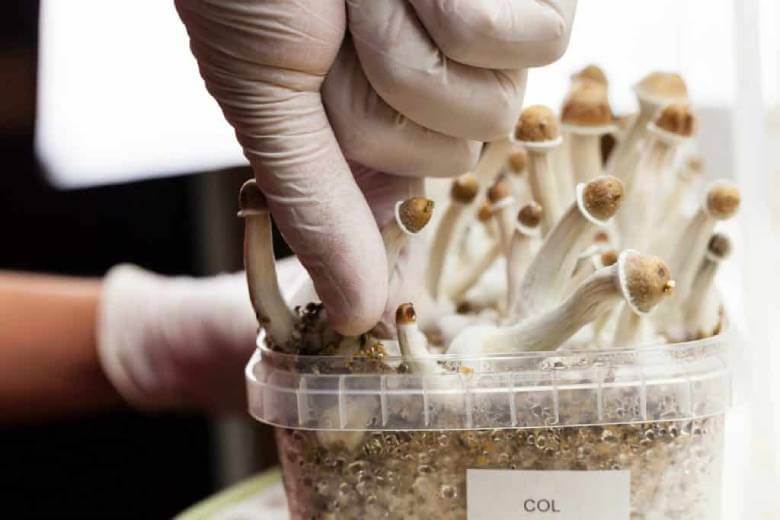Appearance:
B+ Cubensis Magic Mushroom are one of the most popular and well known?Psilocybe cubensis in the modern times. It is a?popular strain for first-time trippers?and beginner mycologists. There is some mystery behind the origins of B+ shrooms. What we know is that it originated from Florida by a cultivator named Mr. G. He developed this strain for easiness and large yields. It didn?t disappoint because this extraordinary strain took over the cultivation community by storm. The B+ magic mushrooms is the best-selling strain since the 90?s.
B+ magic mushrooms are large and have one of the widest caps within the psilocybin cubensis family. This strain is also well known for its positive reviews, it is known to give one of the warmest visual and spiritual trips. It is an all-around and versatile mushroom. Recommended for beginners and experience psychonauts alike.
After 10-30 minutes of consuming B+ mushrooms you will feel your mood enhanced with euphoria and excitement. Depending on dosage you will experience mild to intense visual enhancements. Things may seem like they are breathing, the nature around you will feel more alive and you will find yourself in introspective thought. Music and art will look and feel different and you will have a higher appreciation and you may relate the music or art to yourself on a more personal level. The most common museum dose (0.5-1.5g) and moderate dose (2-3.5g) should provide you with a 3-6 hour trip.
B+ Cubensis Magic Mushroom Effects
The high from B+ cubensis is rich and well-balanced. Frequently a good choice for beginners. The trip is usually pleasant, with a moderate level of difficulty. Mild visual trips are present, as is moderate euphoria. Acute visuals may be present at higher doses. A mild sense of hallucination, as well as a warped feeling. On B+ cubensis and higher doses, time and perception may ?warp.? At lower doses, B+ cubensis is an excellent choice for beginners.
How To Grow B+ Cubensis Magic Mushroom:
STEP 1: PREPARATION
1) Prepare jars:
- With the hammer and nail (which should be wiped with alcohol to disinfect) punch four holes down through each of the lids, evenly spaced around their circumferences.
2) Prepare substrate:
- For each jar, thoroughly combine ? cup vermiculite and ? cup water in the mixing bowl. Drain excess water using the disinfected strainer.
- Add ? cup brown rice flour?per half-pint jar?to the bowl and combine with the moist vermiculite.
3) Fill jars:
- Being careful not to pack too tightly, fill the jars to within a half-inch of the rims.
- Sterilize this top half-inch with rubbing alcohol
- Top off your jars with a layer of dry vermiculite to insulate the substrate from contaminants.
4) Steam sterilize:
- Tightly screw on the lids and cover the jars with tin foil. Secure the edges of the foil around the sides of the jars to prevent water and condensation from getting through the holes.
- Place the small towel (or paper towels) into the large cooking pot and arrange the jars on top, ensuring they don?t touch the base.
- Add tap water to a level halfway up the sides of the jars and bring to a slow boil, ensuring the jars remain upright.
- Place the tight-fitting lid on the pot and leave to steam for 75-90 minutes. If the pot runs dry, replenish with hot tap water.
NOTE:?Some growers prefer to use a pressure cooker set for 60 minutes at 15 PSI.
5) Allow to cool:
- After steaming, leave the foil-covered jars in the pot for several hours or overnight. They need to be at room temperature before the next step.
STEP 2: INOCULATION
1) Sanitize and prepare syringe:
- Use a lighter to heat the length of your syringe?s needle until it glows red hot. Allow it to cool and wipe it with alcohol, taking care not to touch it with your hands.
- Pull back the plunger a little and shake the syringe to evenly distribute the magic mushroom spores.
NOTE:?If your spore syringe and needle require assembly before use, be extremely careful to avoid contamination in the process. Sterilized latex gloves and a surgical mask can help, but the surest way is to assemble the syringe inside a disinfected still air or glove box.
2) Inject spores:
- Remove the foil from the first of your jars and insert the syringe as far as it will go through one of the holes.
- With the needle touching the side of the jar, inject approximately ? cc of the spore solution (or slightly less if using a 10 cc syringe across 12 jars).
- Repeat for the other three holes, wiping the needle with alcohol between each.
- Cover the holes with micropore tape and set the jar aside, leaving the foil off.
- Repeat the inoculation process for the remaining jars, sterilizing your needle with the lighter, and then alcohol between each.
STEP 3: COLONIZATION
1) Wait for the mycelium:
- Place your inoculated jars somewhere clean and out of the way. Avoid direct sunlight and temperatures outside 70-80 ?F (room temperature).
- White, fluffy-looking mycelium should start to appear between seven and 14 days, spreading outward from the inoculation sites.
NOTE:?Watch out for any signs of contamination, including strange colors and smells, and dispose of any suspect jars immediately. Do this outside in a secure bag without unscrewing the lids. If you?re unsure about whether a jar is contaminated, always err on the side of caution?even if the substrate is otherwise healthily colonized?as some contaminants are deadly for humans.
2) Consolidate:
- After three to four weeks, if all goes well, you should have at least six successfully colonized jars. Leave for another seven days to allow the mycelium to strengthen its hold on the substrate.
STEP 4: PREPARING THE GROW CHAMBER
1) Make a shotgun fruiting chamber:
- Take your plastic storage container and drill ?-inch holes roughly two inches apart all over the sides, base, and lid. To avoid cracking, drill your holes from the inside out into a block of wood.
- Set the box over four stable objects, arranged at the corners to allow air to flow underneath. You may also want to cover the surface under the box to protect it from moisture leakage.
NOTE:?The shotgun fruiting chamber is far from the best design, but it?s quick and easy to build and does the job well for beginners. Later, you may want to try out alternatives.
2) Add perlite:
- Place your perlite into a strainer and run it under the cold tap to soak.
- Allow it to drain until there are no drips left, then spread it over the base of your grow chamber.
- Repeat for a layer of perlite roughly 4-5 inches deep.
STEP 5: FRUITING
1) ?Birth? the colonized substrates (or ?cakes?):
- Open your jars and remove the dry vermiculite layer from each, taking care not to damage your substrates, or ?cakes?, in the process.
- Upend each jar and tap down onto a disinfected surface to release the cakes intact.
2) Dunk the cakes:
- Rinse the cakes one at a time under a cold tap to remove any loose vermiculite, again taking care not to damage them.
- Fill your cooking pot, or another large container, with tepid water, and place your cakes inside. Submerge them just beneath the surface with another pot or similar heavy item.
- Leave the pot at room temperature for up to 24 hours for the cakes to rehydrate.
3) Roll the cakes:
- Remove the cakes from the water and place them on a disinfected surface.
- Fill your mixing bowl with dry vermiculite.
- Roll your cakes one by one to fully coat them in vermiculite. This will help to keep in the moisture.
4) Transfer to grow chamber:
- Cut a tin foil square for each of your cakes, large enough for them to sit on without touching the perlite.
- Space these evenly inside the grow chamber.
- Place your cakes on top and gently mist the chamber with the spray bottle.
- Fan with the lid before closing.
5) Optimize and monitor conditions:
- Mist the chamber around four times a day to keep the humidity up, taking care not to soak your cakes with water.
- Fan with the lid up to six times a day, especially after misting, to increase airflow.
NOTE:?Some growers use fluorescent lighting set on a 12-hour cycle, but indirect or ambient lighting during the day is fine. Mycelium only needs a little light to determine where the open air is and where to put forth mushrooms.
STEP 6: HARVESTING
1) Watch for fruits:
- Your mushrooms, or fruits, will appear as tiny white bumps before sprouting into ?pins.? After 5-12 days, they?ll be ready to harvest.
2) Pick your fruits:
- When ready, cut your mushrooms close to the cake to remove. Don?t wait for them to reach the end of their growth, as they?ll begin to lose potency as they mature.
NOTE:?The best time to harvest mushrooms is right before the veil breaks. At this stage, they?ll have light, conical-shaped caps and covered gills.
B+ Shrooms Dosage Guide
Classification:?Hallucinogenic
Cultivation Difficulty:?Easy
Substrates:?Equine dung and Enriched soil
Temperature:?Subtropical/ temperate climates
Strain Origin:?Unknown (possibly Florida) ? Mr. G
Everyone?s physiology and metabolism differ, and individual brain chemistry and body size, as well as your surroundings and emotional state, all play a?significant?role in how each individual may respond to psilocybin, so if it?s your first time or you?re significantly increasing your dosage, choose a safe, comfortable, and if possible, familiar location, and consider asking a sober trip sitter to be present. Teas are always a good option if you want a lighter, microdose effect.
Legality:
Psilocybin?and?psilocin?are listed as?Schedule I drugs?under the United Nations 1971?Convention on Psychotropic Substances.[21]?However, mushrooms containing psilocybin and psilocin are not illegal in some parts of the world. For example, in Brazil they are legal, but extractions from the mushroom containing psilocybin and psilocin remain illegal. In the United States, growing or possessing?Psilocybe cubensis?mushrooms is illegal in all states, but it is legal to possess and buy the spores for microscopy purposes.






Reviews
There are no reviews yet.